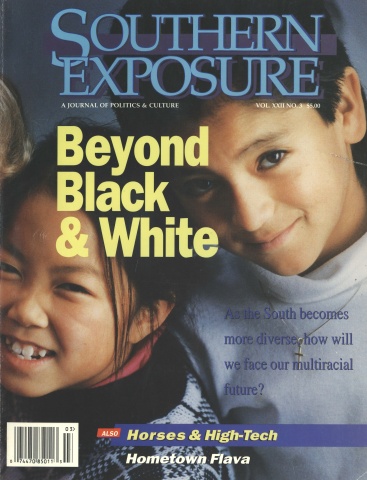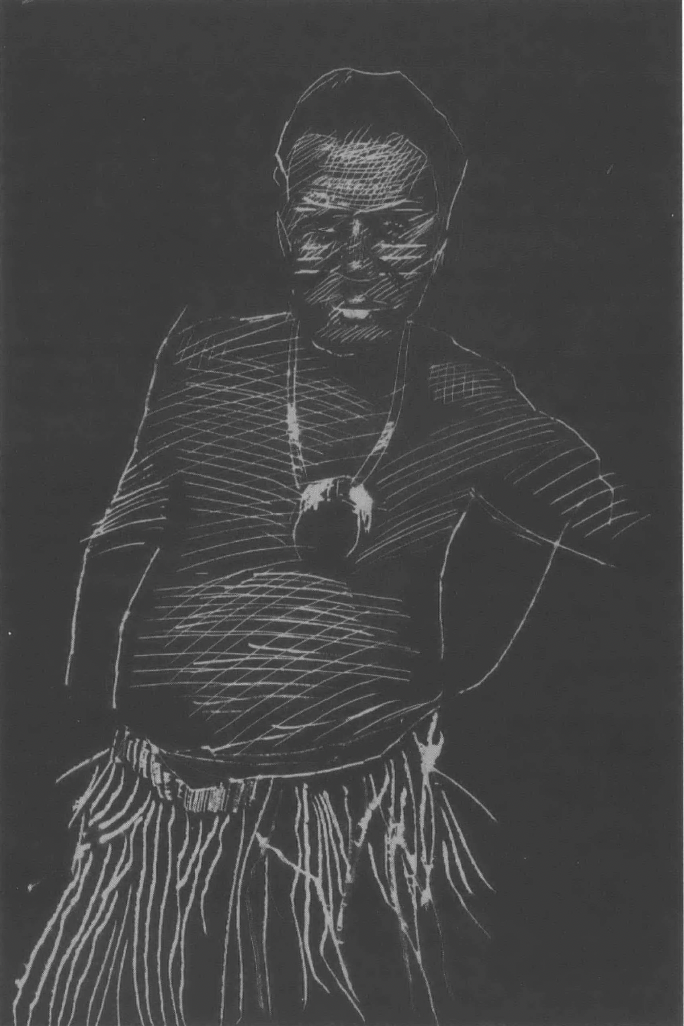
This article originally appeared in Southern Exposure Vol. 22 No. 3, "Beyond Black and White." Find more from that issue here.
I got the job in Hawaii and figured since I’d be in Paradise, I might as well hang out for a while, make a vacation of it. Hawaii! Even the name conjures up pictures of tropical fancy. Okay, so I had heard of the way the native people had been bumfuzzled out of their land. Considering what happened to black people and the road our Native American sisters and brothers have had to walk in North and South America, it didn’t take a lot of imagination to get the picture. But I was bound and determined to make this a vacation!
When my friends heard about my plans, they told me about the Hawaiian Sovereignty Movement. I wanted to plug my ears. Finally this radical community organizer (who probably hasn’t had a vacation since Bessie kicked the milk pail) said, “The least you could do is make up a button saying something like, ‘I SUPPORT THE HEROIC STRUGGLE OF THE NATIVE HAWAIIAN PEOPLES MOVEMENT.’”
“Yeah,” I told her, “and when I go to the beach I could write it on a picket sign and stick it in the sand to make a shady spot.”
She didn’t like my joke.
What most people call Hawaii is eight pretty big islands in a string of smaller islands stretched out along a fault line in the middle of the Pacific Ocean. Hawaii marks the northern end of the huge triangle of about 5,000 miles to a side called Oceania, which includes Polynesia, Micronesia, and Melanesia (the “Black Islands” where a bunch of African people have been living for over 40,000 years! I can hardly wait to get down there).
Once you get out of the big cities, Hawaii really does look like the Garden of Eden. In some places we played on black sand beaches, and heard about beaches of red and green sand, too.
On the other hand, you can also get a picture of hell when you stand on the rim and look down into the crater of a live volcano. Magma boils up from the core of the earth, and lava carves secret tunnels as it snakes down rugged slopes to shoot steamy, sulfur-smoke clouds over the sea and build towers of rock and fire high in the air. You can actually see new land being added to volcanoes which have reared up from the bottom of the sea. I stood on land that was less than two weeks old and felt the earth as it continued to move beneath my feet. I was humbled and honored to stand in witness to such awesome power.
The story goes that an English fortune-hunting sea captain called James Cook “discovered” the Hawaiian Islands in 1784. What that really means is that he was the first one to get back to Europe to tell about it. Polynesian people discovered this paradise, made homes, and lived there centuries before Europeans made the scene.
Since I knew I wouldn’t be able to stay long enough to get very many stories from the people we’d meet, I wanted quick ways to bone up on their history. A bunch of folks told me that the Polynesian Cultural Center, which was developed by a branch of Brigham Young University, was the best place to do that.
I was excited about being able to enjoy a day-long educational experience. I remembered the times I went to Colonial Williamsburg in Virginia and to Harper’s Ferry in West Virginia and thought, “This is going to be better than that!”
I should have known that something was wrong when I got to the cultural center and they wanted from $35 to $85 just to get in the place. I thought about it for a bit and figured, since the employees are mostly Polynesian students working their way through the university, it must be all right. So I coughed up the cash and went in.
We started off at a big-screen movie that gave a 40-minute dramatic history of the region. The movie ended with the arrival of the Europeans. When the English sailors were met by the excited islanders, the cabin boy said, “We found it, Captain! We’re here!”
“Yes, lad,” the Captain said darkly, “for better or for worse.”
After the movie, to get familiar with the exhibits that they have at the center, we took a boat ride that was set up to look like an imaginary journey through the various island nations. As we passed Fiji, a big black man in a grass skirt, war paint on his face, and a spear in his hand jumped out from behind a clump of plants and said, “BOO!” It began to be clear that the center wasn’t going to give us much of an education about a unique part of the world with real people demonstrating their culture and reenacting scenes from their history. What we found instead was a theme park about wild, exotic, primitive, tropic peoples who luckily have been tamed by our superior culture.
To tell the truth, it hurt my feelings. It put me in mind of the Walt Disney version of Southern culture in that movie Song of the South. It felt like some serious “signifying” was going on.
Said the Signifying Monkey to the lion one day,
“Man, you ought to hear what I heard the elephant say,
He was talking about your momma, and your papa too,
And he didn’t have too much nice to say about you.
Man, he talked about you and your people so bad-d-d-d!
The way he talked about y’all, well, it made me mad!
Course, the Signifying Monkey was just stirring up mess, but the so-called Polynesian Cultural Center did hurt my feelings. It reminded me of the time I went to the Alamo in San Antonio, Texas.
I remember all those World War II movies with paratroopers jumping out of planes yelling “Remember the Alamo!” And then there were all those Westerns that made it look like William Travis and Daniel Boone and all those guys who got wiped out by General Santa Anna at the little mission house by the river were heroes instead of outlaws. In fact, Travis and his gang were just that — outlaws who went against the laws of the governments of Mexico, the United States, and Texas. Travis, it seems, was upset because he was on the losing side of the Civil War and was looking for a fight he could be on the winning side of.
The thing that made me feel so bad about going to the Alamo was that the tour was guided by Mexican youths who had to smile pleasantly while they told the story of how their ancestors — trying to defend their country in an honorable way — had won the battle but lost the war. I felt like I’d been cheated. I found out that people who I’d been taught to think of as heroes were really outlaws. Why have our schools and the movies, with the support of our government, led us to this wrong idea about history? It was like saying that Harriet Tubman, Nat Turner, and John Brown were crazy for resisting slavery. Or that Native Americans ought to build a monument for Custer at the Little Big Horn.
That’s what I thought about as I left the theme park called the Polynesian Cultural Center. It would have been so much better if the designers of the park had spent more time at Colonial Williamsburg or Harper’s Ferry, and less time at Disneyland.
I hear that Disney is trying to get approval for a plan to build a big theme park about American history in Manassas, Virginia. Lord have mercy on us if the same people who gave us Donald Duck, Mickey Mouse, Goofy, and the gang get the chance to make their view of history official. I can see it now — Uncle Remus with Betsy Ross and Scrooge McDuck with Harriet Tubman, dancing arm in arm and leading the chorus of “It’s a Small World After All.”
Think it’s impossible? Remember the Alamo!
Tags
Junebug Jabbo Jones
Junebug Jabbo Jones sends along stories from his home in New Orleans through his good friend John O’Neal. (1994-1997)
John O'Neal
John O'Neal was a co-founder and director of the Free Southern Theater for almost 20 years. He is currently touring the nation in his one-person play, Don't Start Me Talking Or I'll Tell Everything I Know: Sayings from the Life and Writings of Junebug Jabbo Jones. (1984)
John O ’Neal is co-founder and director of the Free Southern Theater in New Orleans. O’Neal’s one-person play, “Don’t Start Me to Talking Or I’ll Tell Everything I Know, ” is currently touring the country. (1981)

